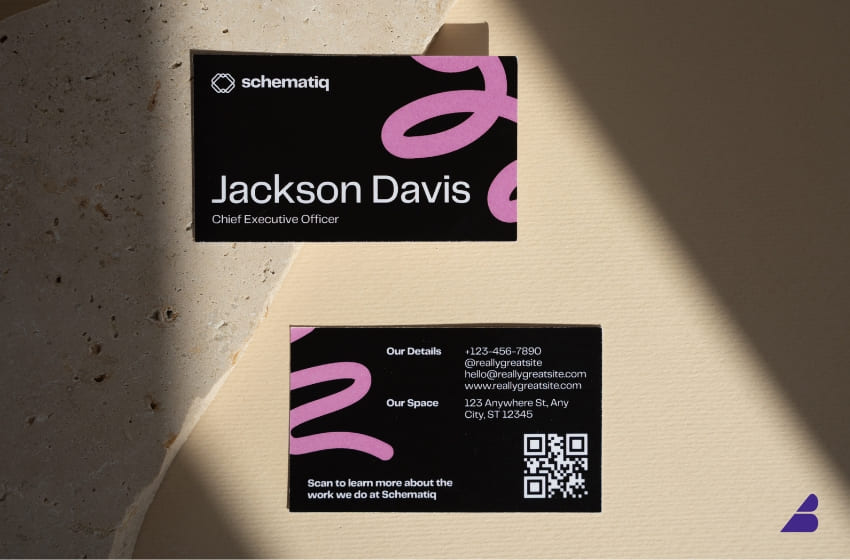
In today’s fast-paced digital world, traditional paper business cards are evolving into smart business cards with cutting-edge technologies like NFC (Near-Field Communication), QR codes, and digital integrations. These innovations not only make networking seamless but also enhance brand visibility and engagement.
If you’re still using conventional business cards, it’s time to upgrade. Let’s explore how smart business cards are transforming professional interactions and why your brand needs one.
1. What Are Smart Business Cards?
Smart business cards digitally store and share contact information using technologies like:
- NFC (Near-Field Communication) – Tap the card on a smartphone to instantly transfer contact details.
- QR Codes – A scannable code that links to your portfolio, LinkedIn, website, or digital business card.
- App-Based Digital Cards – Platforms like HiHello, Blinq, and Popl allow for interactive, shareable cards without physical copies.
Unlike traditional business cards, which are easy to lose or misplace, smart business cards ensure instant access and long-term connectivity.
2. The Rise of NFC Business Cards
🔹 What is NFC and How Does it Work?
NFC (Near-Field Communication) is the same technology used in contactless payments. When an NFC-enabled card is tapped on a smartphone, it triggers an action—like opening a contact page, website, or social media profile.
✅ Advantages of NFC Business Cards:
✔ Instant Information Sharing – No need for manual typing; just tap and save.
✔ Eco-Friendly & Cost-Effective – Reduce paper waste and printing costs.
✔ Customizable Actions – Direct users to a landing page, video, or calendar booking.
✔ Future-Proof Networking – Works with both iOS and Android devices.
💡 Example: A real estate agent can share property listings instantly, while a freelancer can link to their portfolio or payment page.
3. QR Code Business Cards: Simple & Versatile
🔹 How QR Code Business Cards Work
A QR code (Quick Response code) is a scannable square pattern that links to digital contact details, social profiles, or a website.
✅ Benefits of QR Code Business Cards:
✔ Easy to Scan – Works with any smartphone camera, no app needed.
✔ Highly Customizable – Add your logo, colors, and branding elements.
✔ Trackable Analytics – Monitor how often your QR code is scanned.
✔ Multi-Platform Integration – Link to LinkedIn, Calendly, WhatsApp, or digital resumes.
💡 Example: A graphic designer can create a QR code linking to their Behance or Dribbble portfolio, making it easy for potential clients to view their work.
4. Digital Business Cards & App-Based Networking
Many professionals are ditching physical business cards entirely and switching to app-based digital business cards.
🔹 Top Digital Business Card Platforms:
📱 HiHello – Customizable virtual cards with multiple sharing options.
📱 Blinq – Allows NFC, QR code, and social media integrations.
📱 Popl – Focuses on NFC-based business cards with analytics.
✅ Why Go Fully Digital?
✔ Zero Physical Printing Costs – Update details anytime, no reprints needed.
✔ Easy Cloud Storage – Never lose a contact again.
✔ Seamless CRM Integration – Sync contacts with HubSpot, Salesforce, or Google Contacts.
✔ Instant Sharing via Email, Text, or Social Media – No need to be physically present.
💡 Example: A consultant attending global events can share their digital card via email or WhatsApp, ensuring effortless networking.
5. Smart Business Cards vs. Traditional Business Cards
| Feature | Smart Business Cards | Traditional Business Cards |
|---|---|---|
| Contact Sharing | Instant via NFC, QR, or apps | Manual exchange |
| Updates | Editable anytime | Requires reprinting |
| Eco-Friendliness | No paper waste | Paper-based |
| Integration | Works with CRM, social media, and calendars | No digital connectivity |
| Cost-Effectiveness | One-time investment | Recurring printing costs |
Clearly, smart business cards offer greater efficiency, sustainability, and connectivity compared to traditional business cards.
6. How to Choose the Right Smart Business Card for Your Brand
🔹 Consider Your Audience:
- If you network frequently in tech or business, NFC business cards offer the fastest interactions.
- If your contacts prefer flexibility, a QR code business card allows instant scanning.
- If you want full digital control, app-based business cards are the best choice.
🔹 Branding Matters:
- Customize your digital card to match your brand colors and style.
- Ensure your landing page or contact details are professional and updated.
🔹 Test Compatibility:
- Not all smartphones have NFC enabled—always have a QR code backup.
- Ensure your digital card links work on all devices and platforms.
💡 Pro Tip: Combine NFC + QR + Digital to create the ultimate smart business card solution.
7. The Future of Smart Business Cards
🚀 2025 Trends to Watch:
🔹 AI-Powered Networking – Smart cards will auto-recommend connections based on interests.
🔹 Augmented Reality (AR) Cards – 3D holographic business cards for immersive engagement.
🔹 Blockchain-Verified Credentials – Secure, tamper-proof digital identity for professionals.
🔹 Voice-Activated Business Cards – Share contact details via voice commands.
With digital transformation accelerating, smart business cards will soon become the standard for modern networking.
Final Thoughts: Is It Time to Upgrade?
If you want to stand out in business, build meaningful connections, and embrace digital-first networking, smart business cards are a game-changer.
Whether you choose NFC, QR codes, or app-based digital cards, the key is to make networking seamless, professional, and memorable.
💡 Ready to switch to a smart business card? 🚀




